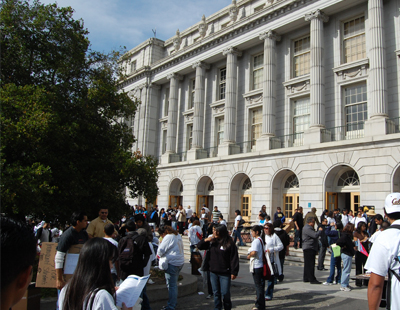
College completion still a challenge ---
Driven by a single-year surge of 24% in Hispanic enrollment, the number of 18- to 24-year-olds attending college in the United States hit an all-time high of 12.2 million in October 2010, according to a Pew Hispanic Center analysis of newly available Census Bureau data. From 2009 to 2010, the number of Hispanic young adults enrolled in college grew by 349,000, compared with an increase of 88,000 young blacks and 43,000 young Asian Americans and a decrease of 320,000 young non-Hispanic whites.
It's the largest increase on record, and is significant because it's substantially higher than the 7 percent increase in the overall population of Hispanics that age.
Driven by a single-year surge of 24% in Hispanic enrollment, the number of 18- to 24-year-olds attending college in the United States hit an all-time high of 12.2 million in October 2010, according to a Pew Hispanic Center analysis of newly available Census Bureau data. From 2009 to 2010, the number of Hispanic young adults enrolled in college grew by 349,000, compared with an increase of 88,000 young blacks and 43,000 young Asian Americans and a decrease of 320,000 young non-Hispanic whites.
It's the largest increase on record, and is significant because it's substantially higher than the 7 percent increase in the overall population of Hispanics that age.
"In the Great Recession, job markets, particularly for the nation's young in many states, significantly deteriorated," said Richard Fry, senior research associate at Pew Hispanic. "For some youth, work is an alternative to school. They can't find jobs, so why not finish high school? Why not go to college?"
The data shows that young Hispanics for the first time outnumbered young blacks on campus. The Hispanic enrollment increase has been even more dramatic than the black enrollment increase because it has been spurred by a mixture of population growth and educational strides. High levels of immigration and high birth rates have made Hispanics the nation's biggest minority group, comprising 16% of the U.S. population as of 2010.
Hispanics, however, still continue to be well below the national average in completion of four-year college degrees. In 2010 32% of 25- to 29-year-olds had attained a bachelor's degree, in comparison to 13% of Hispanics of the same age.
Of course, national data doesn’t necessarily reflect the reality in every community. Here in the East Bay, the Peralta Community College District - which includes colleges such as Laney College and Merritt College – has a different ethnic profile in its student population. According to Jeffrey Heyman, spokesperson for the Peralta district, Hispanic students were only 12.2 percent of the district´s enrollment in 2010, which is a one percent increase over 2009. Black students represent 25.1 percent, Asian students 20.9 percent and White Non-Hispanics 17.7 percent. He adds that there are other important factors affecting enrollment numbers in the district and nationally, mainly funding cuts and the enrollment limit set by state governments.
“The culture of low education expectation in the Latino community is beginning to crack,” says Graciela Tiscareño-Sato, a Hayward resident who works with Latino students and lawmakers in Washington to increase student achievement.
“I am very happy to see the number increase for one year but it´s not enough,” adds Tiscareño-Sato, who is also author of the book, ´Latinnovating: Green American Jobs and the Latinos Creating Them´.
She says her focus is on the absolute numbers. “The dropout rate among Latinos is disappointing – nationally, we are still only graduating 130,000 Latinos per year from college. The culture is still not expecting people to be educated. I will be happy when we see a surge in college graduates.”
Tiscareño-Sato believes that mentoring young students is the key to achieving real educational progress for Hispanics. She urges adults to become mentors and make a young person believe college is indeed for them. “You may be the only one saying this to this young person,” she writes. “Be the force that guides the student from where they are to where they need to be — in college and beyond.”
